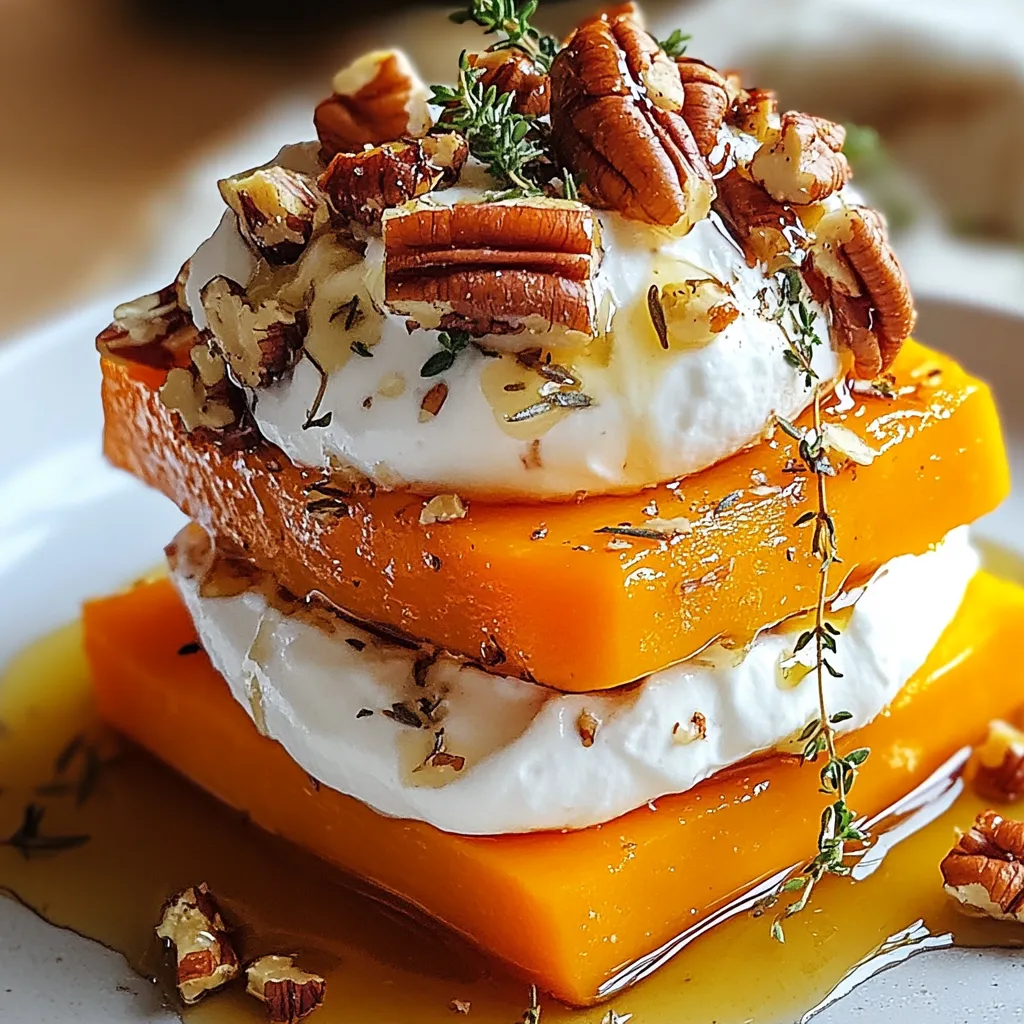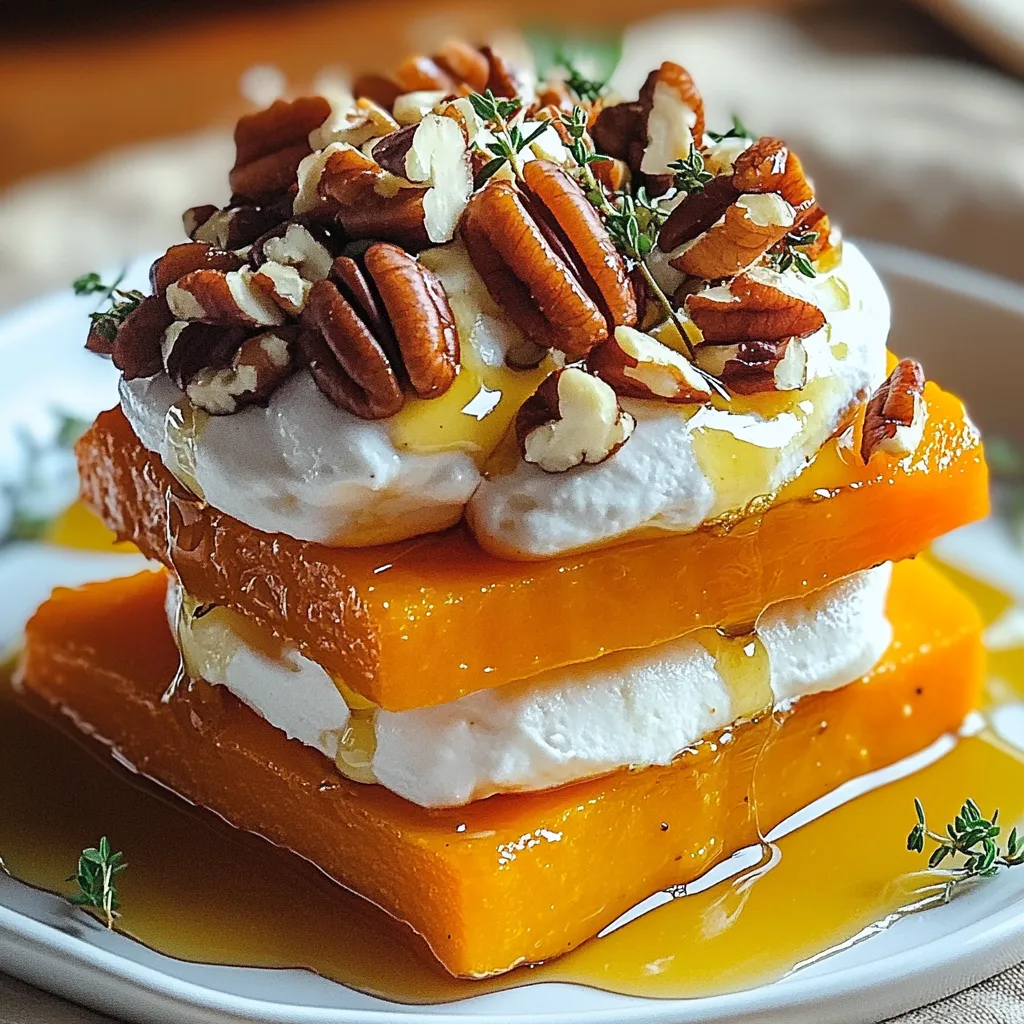 Save
Save
Honey-pecan sweet potato goat cheese delight transforms simple ingredients into an elegant dish that balances contrasting flavors and textures in perfect harmony. Tender roasted sweet potatoes provide an earthy sweetness that pairs beautifully with the tangy creaminess of goat cheese. Toasted pecans add a satisfying crunch, while a drizzle of honey brings everything together with its golden sweetness. This versatile creation works beautifully as an elevated appetizer, a distinctive side dish, or even a light meal that feels both nourishing and indulgent. I discovered this combination years ago when looking for an easy yet impressive dish for a dinner party, and it's become my signature offering whenever I want to create something memorable without spending hours in the kitchen.
I first served this at a holiday gathering where I needed something that could sit at room temperature while guests mingled. My aunt, who typically avoids "health food" like sweet potatoes, tried it to be polite and ended up asking for the recipe before the evening ended. There's something magical about how the tangy goat cheese cuts through the sweetness of the potatoes and honey, creating a perfectly balanced bite that leaves people reaching for more. Now it's requested at every family gathering, and I'm happy to oblige since it's so simple to prepare.
Nature's Ingredients
- Sweet Potatoes: Form the foundation with their natural sweetness and velvety texture when roasted. Choose firm potatoes with deep orange flesh for the richest flavor and most beautiful presentation.
- Fresh Goat Cheese: Provides creamy tanginess that balances the sweet elements perfectly. Opt for a soft, spreadable variety with a clean flavor profile – artisanal versions often have the most complex flavor.
- Quality Pecans: Deliver essential crunch and nutty depth. Look for plump, golden-brown nuts with no discoloration for the freshest flavor and best texture.
- Local Honey: Ties all elements together with floral sweetness. Different varieties offer unique flavor notes – orange blossom honey brings citrus undertones while wildflower adds complexity.
- Extra Virgin Olive Oil: Enhances roasting with rich flavor and helps achieve caramelized edges. A fruity, high-quality oil makes a noticeable difference in the final taste.
- Flaky Sea Salt: Amplifies all other flavors and provides occasional bursts of salinity. Maldon or fleur de sel add textural interest and clean flavor.
- Fresh Herbs: Optional but highly recommended for visual appeal and aromatic brightness. Thyme provides earthy notes while rosemary offers pine-like fragrance.
Cooking Method
- Prepare Perfect Potatoes:
- Begin by selecting sweet potatoes of similar thickness to ensure even cooking. Preheat your oven to a hot 400°F, which provides the perfect environment for caramelization without burning. After peeling the sweet potatoes, slice them into rounds approximately half an inch thick – this size allows them to cook through while maintaining their structure. For a more rustic presentation, you can cut them into small wedges instead. Arrange the pieces in a single layer on a parchment-lined baking sheet, giving them space to breathe rather than crowding them together. This crucial spacing allows moisture to evaporate properly, promoting caramelization instead of steaming. Drizzle generously with olive oil, then season with salt and freshly ground black pepper. Using your hands, toss to ensure each piece is evenly coated, which protects against drying out while promoting even browning.
- Master the Roasting:
- Place the baking sheet in the center of your preheated oven, where heat distribution is most consistent. Roast for about 20-25 minutes total, but don't walk away – the key to perfection is flipping each piece halfway through cooking. This attention to detail ensures golden caramelization on both sides rather than uneven coloring. You'll know they're done when the edges develop a deep golden brown and the centers yield easily to a fork while still maintaining their shape. The natural sugars in the sweet potatoes will have concentrated during roasting, intensifying their flavor. Allow them to cool slightly before assembling – they should be warm but not hot enough to melt the goat cheese completely.
- Toast for Maximum Flavor:
- While the sweet potatoes roast, prepare the pecans to maximize their flavor and texture. Place them in a dry skillet over medium heat – no oil needed as the nuts contain natural oils. Shake the pan frequently to ensure even toasting and prevent burning, which happens quickly with nuts. After 3-4 minutes, you'll notice a dramatic transformation – they'll become fragrant with a deeper color and more pronounced flavor. Remove them from the heat immediately when they reach this point, as they'll continue cooking slightly from residual heat. Allow them to cool completely before using, which ensures they maintain their satisfying crunch against the softer elements of the dish.
- Assemble with Artistry:
- Arrange the roasted sweet potato pieces on a serving platter or individual plates, depending on how you plan to serve. While still warm, top each piece with a small portion of goat cheese – either a slice from a log or a dollop of the crumbled variety. The residual heat will slightly soften the cheese without melting it completely, creating the perfect creamy texture. Scatter the toasted pecans across the top, distributing them evenly so each serving includes their delightful crunch. Just before serving, drizzle the entire dish with honey, allowing it to cascade down the sides of the sweet potatoes and pool slightly on the plate. This final touch not only adds sweetness but creates a beautiful, glossy finish. If using, sprinkle with fresh herbs for color contrast and aromatic complexity.
 Save
Save
I learned the importance of properly toasting nuts after serving this with raw pecans at an early dinner party – the difference in flavor was remarkable when I started taking the extra few minutes to toast them. My neighbor, a professional chef, suggested arranging the components on a wooden board with small bowls of extra honey and goat cheese on the side for guests to customize their portions. This interactive presentation has become my preferred method for casual gatherings, creating a beautiful centerpiece that encourages conversation. My teenage daughter, initially skeptical of goat cheese, now requests this dish regularly and has even learned to make it herself.
Serving Ideas
This versatile dish shines in numerous settings. For an elegant dinner party starter, arrange individual portions on small plates with a fork, allowing guests to enjoy it seated. As a side dish, serve alongside roasted chicken or grilled lamb chops, where its sweetness complements the savory meat beautifully. For holiday meals, prepare it on a large decorative platter as part of a buffet – it looks stunning and can be enjoyed at room temperature.
When hosting brunch, consider serving smaller portions alongside a frittata or quiche for a sweet-savory pairing that delights mid-morning appetites. For a light lunch, increase the portion size and accompany with a simple green salad dressed with lemon vinaigrette. The contrasting flavors and textures create a satisfying meal that feels both nourishing and special. For wine pairings, a crisp Sauvignon Blanc or lightly oaked Chardonnay complements the flavors beautifully.
Flavorful Variations
Mediterranean Inspiration: Transform the flavor profile by replacing the honey with a drizzle of balsamic glaze and adding chopped fresh figs when in season. Sprinkle with finely chopped fresh rosemary and a light dusting of crushed red pepper flakes for heat. This variation creates a sophisticated Mediterranean-inspired dish that pairs beautifully with grilled meats or as part of an antipasto spread.
Breakfast Transformation: Create a morning-friendly version by serving the sweet potatoes and goat cheese on toasted artisan bread. Drizzle with honey, sprinkle with cinnamon-sugared pecans, and add a few thin slices of crisp apple for freshness. This variation transforms the concept into a crave-worthy breakfast or brunch option that feels indulgent while providing sustained energy.
Seasonal Celebration: Adapt the dish through the seasons by incorporating dried cranberries and orange zest in winter, fresh cherries and mint in summer, or sliced pears and thyme in autumn. These simple additions allow you to keep the basic technique while creating distinctly seasonal variations that showcase the best produce available throughout the year.
Fresh Storage
Keeping Components: For best results, store each element separately to maintain their distinct textures and flavors. Place roasted sweet potatoes in an airtight container in the refrigerator for up to three days. Keep toasted pecans in a cool, dry container at room temperature where they'll maintain their crunch. The goat cheese should remain in its original packaging or wrapped tightly in the refrigerator until needed.
Refreshing Leftovers: To revive refrigerated sweet potatoes, warm them in a 350°F oven for 5-7 minutes until just heated through. Avoid microwaving, which can make them soggy and affect their texture. Allow them to cool slightly before adding fresh goat cheese, room-temperature pecans, and a new drizzle of honey. This approach ensures each component maintains its optimal texture and flavor.
Meal Prep Potential: For advance preparation, roast the sweet potatoes and toast the pecans up to three days before serving. Store properly as described above, then assemble just before serving. This approach makes the dish extremely convenient for entertaining while ensuring the freshest possible presentation and flavor.
 Save
Save
I've come to treasure this recipe not just for its delicious flavor combination but for its remarkable versatility and reliability. There's something deeply satisfying about creating a dish that feels special enough for celebrations yet simple enough for everyday enjoyment. The contrasting elements – sweet and tangy, soft and crunchy, warm and cool – create a sensory experience that keeps people coming back for another bite. What began as a simple experiment has become one of my signature dishes, requested by friends and family for gatherings of all kinds. The best recipes, I've found, aren't always the most complex, but rather those that bring out the best in each ingredient while creating something greater than the sum of their parts.
Common Questions About Cooking
- → Can I make these sweet potato bites ahead of time?
- Yes, you can prepare the components ahead of time. Roast the sweet potatoes and toast the pecans up to 2 days in advance, store in the refrigerator, then reheat the potatoes briefly before assembling. For best results, add the goat cheese, pecans, and honey just before serving.
- → What can I substitute for goat cheese?
- If you're not a fan of goat cheese, you can substitute with whipped feta, cream cheese, ricotta, or even a dairy-free alternative like cashew cheese spread. Each will offer a different flavor profile but still pair beautifully with the sweet potatoes.
- → How do I know when my sweet potatoes are done roasting?
- The sweet potato rounds should be fork-tender and lightly golden on the edges. You should be able to easily pierce them with a fork without resistance, but they shouldn't be so soft that they fall apart when handled.
- → Can I use another type of nut instead of pecans?
- Absolutely! Walnuts, almonds, or even pistachios would make excellent substitutes. Just make sure to toast them first to bring out their flavor. For a nut-free version, try toasted pumpkin seeds or sunflower seeds.
- → What's the best way to serve these for a party?
- For best presentation, arrange the assembled bites on a serving platter and drizzle with honey just before guests arrive. They're delicious served warm or at room temperature. If you're taking them to a potluck, consider bringing the components separately and assembling on site.
